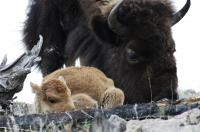
A bison and calf in Yellowstone National Park. Bison can repopulate large areas from Alaska to Mexico over the next 100 years provided a series of conservation and restoration measures are taken, according to continental assessment of this iconic species by the Wildlife Conservation Society and other groups. The assessment was authored by a diverse group of conservationists, scientists, ranchers, and Native Americans/First Nations peoples, and appears in the April issue of the journal Conservation Biology.
The authors say that ecological restoration of bison, a keystone species in American natural history, could occur where conservationists and others see potential for large, unfettered landscapes over the next century. The general sites identified in the paper range from grasslands and prairies in the southwestern U.S., to Arctic lowland taiga in Alaska where the sub-species wood bison could once again roam. Large swaths of mountain forests and grasslands are identified as prime locations across Canada and the U.S., while parts of the desert in Mexico could also again support herds that once lived there.
The researchers assessed the restoration potential of these areas by creating a “conservation scorecard” that evaluated the availability of existing habitat, potential for interaction with other native species, such as elk, carnivores, prairie dogs, and grassland birds, and a variety of other factors, including the socio-economic climate of the regions and the potential for cultural re-connection with bison. The higher the score of these factors, the more likely restoration could take place over time.
“The bison is one of the great living symbols of North America,” said the paper’s lead author, Dr. Eric Sanderson of the Wildlife Conservation Society. “This assessment shows us what is possible; that with hard work and ambitious goals, we can restore this iconic species to a surprising amount of its former range over the next century.”
Bison once numbered in the tens of millions but were wiped out by commercial hunting and habitat loss. By 1889 fewer than 1,100 animals survived. In 1905 the American Bison Society (ABS) formed at WCS’s Bronx Zoo headquarters and began efforts to re-populate reserves on the Great Plains with animals from the zoo’s herd and other sources (bison continue to be exhibited at the Bronx Zoo and Queens Zoo). Of the estimated 500,000 bison existing today, 20,000 are considered wild; the rest live on private ranches.
“The bison is an important part of the heritage of not only the Wildlife Conservation Society but the United States.” said Dr. Steven E. Sanderson, President and CEO of WCS. “One hundred years ago, through our efforts and the efforts of others, the bison was saved from extinction. We are now looking 100 years from now, because we believe there is an ecological future for the bison in the North American landscape.”
The assessment is part of a long-term effort launched in 2006 by the new American Bison Society, led by WCS and including other conservation groups, Native Americans, agencies and private ranchers, to restore the “ecological role” of the bison. According to the groups, ecological restoration would occur when large herds of plains and wood bison can move freely across extensive landscapes within major habitats of their historic ranges. It would also include bison interacting with the fullest possible set of other native species, as well as inspiring, sustaining and connecting human cultures.
Ecological restoration will likely take a century, says WCS, and will only be realized through collaboration with a broad range of public, private and indigenous partners.
Source : Wildlife Conservation Society
 Print Article
Print Article Mail to a Friend
Mail to a Friend
